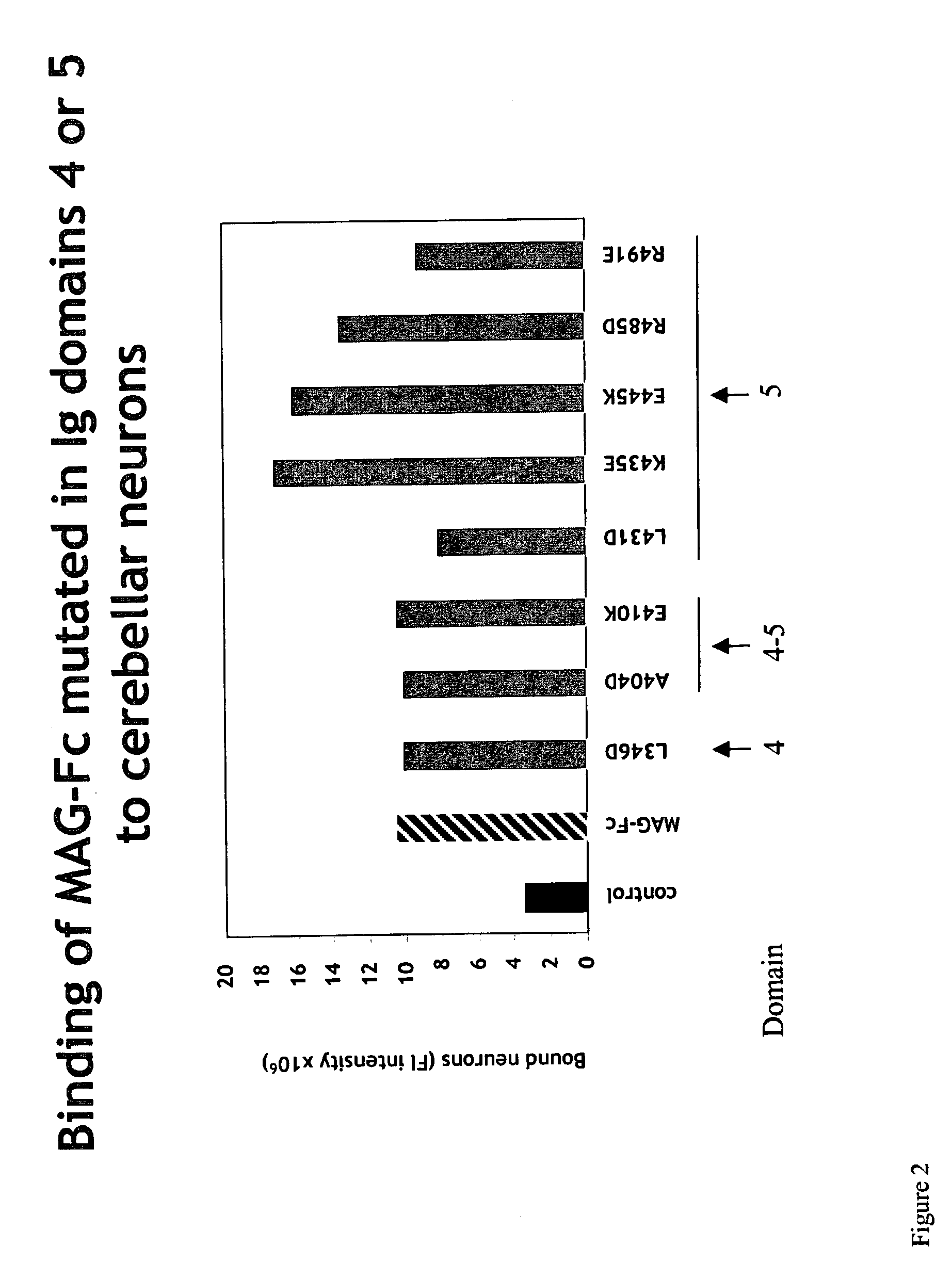Inhibitors of myelin-associated glycoprotein (MAG) activity for regulating neural growth and regeneration
a glycoprotein and myelin technology, applied in the field of inhibitors of myelin-associated glycoprotein (mag) activity, can solve the problems of blocking the ability of any or all of these inhibitors to bind to and activate ngr, and achieve the effects of promoting or inhibiting (neurite outgrowth), promoting neural growth and regeneration, and reducing or eliminating the ability of endogenous inhibitors
- Summary
- Abstract
- Description
- Claims
- Application Information
AI Technical Summary
Benefits of technology
Problems solved by technology
Method used
Image
Examples
example 1
Isolation of Cerebellar Neurons
[0265]Cerebellar neurons were isolated essentially as described in Doherty et al., Nature, 343, pp. 464-66 (1990); Neuron, 5, pp. 209-19 (1990); and Kleitman et al., Culturing Nerve Cells, pp. 337-78, MIT Press, Cambridge, Mass. / London, England (G. Banker and K. Goslin, Eds.) (1991). Briefly, for animals up to nine days of age, the cerebellum was removed from two animals, and placed in 5 ml of 0.025% trypsin in PBS, triturated, and incubated for a further 10 minutes (min) at 37° C. Trypsinization was stopped by addition of 5 ml DMEM containing 10% fetal calf serum (FCS) and cells were centrifuged at 800 rpm for 6 min. The cells were resuspended to a single cell suspension in 2 ml of SATO containing 2% FCS.
example 2
Neurite Outgrowth Assays on Transfected CHO cells
Production of MAG and MAG Derivatives
[0266]Expression plasmids comprising a dhfr gene and, in a 5′-3′ orientation, a cDNA encoding either full-length MAG containing all five Ig-like domains (“MAG”), internally deleted MAG containing Ig-like domains 1-3 (“MAG(1-3)” in FIG. 1; see “MAG(d 1-3)-TM” below); truncated MAG containing Ig-like domains 3-5 (“MAG(3-5)” in FIG. 1; see “MAG(d3-5)-TM”, below); chimeric MAG containing Sn Ig domains 1-3 fused to MAG Ig domains 4 and 5 (“Sn(1-3)MAG(4-5)” in FIG. 1;), chimeric MAG containing Sn Ig domains 1-3 fused to MAG Ig domain 4 fused to Sn domain 5 (Sn(1-3)MAG(4)Sn(5)), and chimeric MAG containing Sn Ig domains 1-4 fused to MAG Ig domain 5 (Sn(1-4)MAG(5)) were constructed, as described below.
[0267]MAG(d1-3)-TM (referred to as “MAG(1-3)” in FIG. 1); contains murine MAG Ig-like domains 1-3 fused to the murine MAG transmembrane domain. DNA composition: murine MAG nucleotide residues 160-1077 (SEQ ID...
example 3
Binding of Wild-type and Mutant
MAG-Fc Chimeras to Neurons
[0278]Expression plasmids encoding various forms of soluble MAG-Fc fusion proteins (such as those referred to herein as MAG(L346D)-Fc), MAG(A404D)-Fc, MAG(E410K)-Fc, MAG(L431D)-Fc, MAG(K435E)-Fc, MAG(E445K)-Fc, MAG(R485D)-Fc, MAG(R491E)-Fc), and a control Fc-chimeric protein (MUC 18-Fc) were constructed using standard molecular biological procedures, as described below. For general discussions and protocols for making soluble recombinant adhesion molecules, see D. L. Simmons, “Cloning cell surface molecules by transient expression in mammalian cells,” in Cellular Interactions in Development—A Practical Approach, pp. 118-125, IRL Press, Oxford (Ed. D. A. Hartley) (1993); Development (Supp.), pp. 193-203 (1993); and P. R. Crocker and S. Kelm, “Methods for studying the cellular binding properties of lectin-like receptors,” in Handbook of Experimental Immunology, pp. 1-30 (1995), which are incorporated herein by reference.
[0279]Th...
PUM
| Property | Measurement | Unit |
|---|---|---|
| Tm | aaaaa | aaaaa |
| temperatures | aaaaa | aaaaa |
| volume | aaaaa | aaaaa |
Abstract
Description
Claims
Application Information
 Login to View More
Login to View More - R&D
- Intellectual Property
- Life Sciences
- Materials
- Tech Scout
- Unparalleled Data Quality
- Higher Quality Content
- 60% Fewer Hallucinations
Browse by: Latest US Patents, China's latest patents, Technical Efficacy Thesaurus, Application Domain, Technology Topic, Popular Technical Reports.
© 2025 PatSnap. All rights reserved.Legal|Privacy policy|Modern Slavery Act Transparency Statement|Sitemap|About US| Contact US: help@patsnap.com



